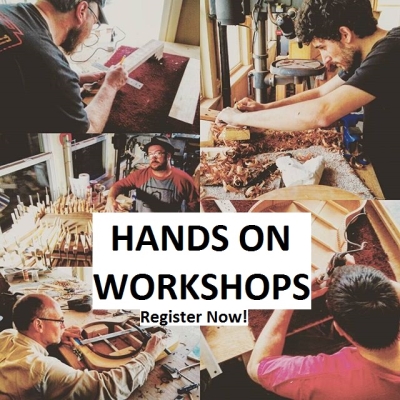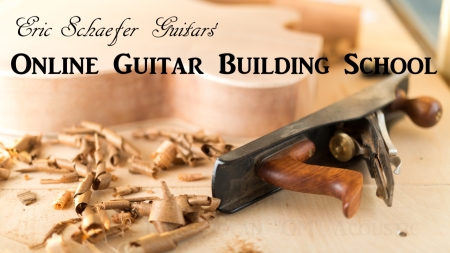 Eric Schaefer Guitars’ Online Guitar Building School
Eric Schaefer Guitars’ Online Guitar Building School
This is a free video from the “Building an OM Acoustic” Course. Click here for more free video tutorials.
Lesson Transcript:
For this course, we are going to use an outside guitar mold. The mold is used during the side bending process and the soundbox assembly process. It also helps you mark out important dimensions in the early stages of the build.
First, we will make a template.
Then we will trace the template onto 3/4″ MDF, plywood, or particle board and cut 6 sections.
each section is then atteched to the original template for refinement on the router table.
The 6 sections are glued together to create 2 pieces.
Hardware is installed to hold the two pieces together and a wooden dowel is installed at the joints to keep the pieces properly aligned.
For my template I am using half of a spare OM mold that I had in my shop, but you will have to create your own template from scratch, using your plans as a guide. To do this, trace half of your guitar’s outline onto tracing paper.
Stick the tracing paper to 3/4″ particle board, MDF, or plywood with spray contact adhesive.
Cut on the line with a bandsaw.
I use a 1/4″ blade or smaller so that it can handle the curves.
Take your time and strive for consistent curves. All major inconsistencies can be smoothed out with 80 grit sandpaper wrapped around a wooden dowel. Minor inconsistencies can be ignored.
As far as precision goes, the inside cut is what really counts. The outside cut can be rough cut to any shape as long as it is about 3 to 5 inches from the inside cut.
Finally, drill 3 holes for use in mounting the template.
Now this is actually just another piece from another mold that I have.
I’m re-purposing it as a template for other molds.
So, with that in mind, yours does not need to be as bulky as this is.
In fact, you could just use a single piece of 3/4″ plywood or something even thinner (half inch plywood would work just fine).
That way, you could carefully, on a bandsaw, cut out the shape as precisely as you can. Because once you cut out that shape we are going to use that first template that you make, that should look something like this, to make the other pieces.
There is going to be 6 pieces overall, 3 stacked on top of each other as you can see here. Having that template makes it real easy. We can make exact copies of each piece using the router with a guide bearing bit.
So now we have our particle board out on the floor. And I’m going to use this template that I made here and trace out 6 copies of this.
So instead of taking this straight to the bandsaw, because it is so big and cumbersome, we’re going to first see if we can cut this up a little bit in place here using a jigsaw. You can use a circular saw. If you have a friend with you, you can take it over to the bandsaw, or the table saw.
I am just going to break it down first this way into some slightly smaller pieces and then we can cut it on the bandsaw.
Okay, now these are small enough to fit in the bandsaw.
So we want to stay about 1/16″ outside this line.
That way, when we take this over to the router table, we will have very little wood left over for that router bit to remove.
So we’ll stay nice and tight to the line.
Okay so now we are going to attach our template to the first piece, so that we can clean up those edges on the router table.
So what I’m going to do is I’m going to hang this over the end like that, and line this up, so that the bottom piece is overhanging just slightly, everywhere.
Okay, both sides are clamped. Let me just look around the edge and make sure we are overhanging a little bit.
And I didn’t drill any pilot holes. If you are using particle board or MDF you don’t need to drill pilot holes.
We can just drive those screws through and it won’t split.
So we are going to use a 1/2″ straight cut bit with a guide bearing. That is what this little wheel is right here.
And so I already have that set up in a good place. The guide bearing is up here against the template.
Now remove the template, attach it to the next section, and continue routing until all 6 sections are complete.
Okay so we’ve cut 6 of these. I’m going to pull 3 over to make our first half of our mold. We’re going to hang this over the edge a little bit.
What I first want to do, is very carefully take my time and get this lined up so that all the pieces are flush with each other.
And I could check that with a square or something but I’m not going to. I can just feel for any overhanging edges. That is pretty good there.
I carefully clamp this up, making sure it doesn’t move. The whole purpose of this is that we are going to drill 2 holes here so we can have locating screws there to keep everything in alignment when we glue all these pieces together.
Otherwise, if we put the glue on there without the locating screws, the whole thing will slide around in the glue once we tried to clamp it down. So this will help us maintain alignment.
No need to measure this out.
So then these 2 screws will go in here. We’re not going to put them in there just yet. So now we can take this apart and we can spread the glue.
I let the glue cure overnight, and now we are ready to remove the clamps and attach the hardware.
Okay, we have the two pieces. Now let’s just add our hardware to it.
The first thing I want to do is mark the holes for this and drill. So I want to set this up for a little more than 1/4″ from this edge here. The reason why I am not super precise is because this handle here is adjustable. Once we get this on, you can always adjust the tension of this arm.
Let’s mark the other piece, which faces this way.
Okay, let’s drill that.
We have the correct size bit for the screws and I put a little flag on there as a depth stop so I drill only as far as I need to drill.
Okay, now we are going to drill for the dowel, which will keep this alignment correct, as far as side to side.
You see that? If we don’t put the dowel in there, it can pull apart like that. So we put the dowel in there to keep it together.
I’m going to clamp it in place at the edge of my workbench.
I’m using a 1/2″ dowel, but really you can use any size dowel, as long as the bit you use matches the size of the dowel.
And this does.
I’m using a forstner bit because it leaves a flat bottom.
I’m just going to rest the brad point right on that line that separates the two pieces.
I’m going to set the depth of the bit. We don’t want to go all the way through.
I’m just going to go down most of the way. I’m going to go halfway through the third sheet of particle board.
So I put a tape flag on here to mark where that will be.
Okay, let’s do the other side.
Press that all the way down to the bottom and I’m just going to mark this off, and cut that real quick on the bandsaw.
Okay, and to glue this in place, very simple, I’m just going to run a bead of glue down the edge like that. Press it in place. Place some wax paper over, so we don’t glue the whole thing stuck together.
And to clamp we can just close that up, just like that.
Okay, let that glue cure for about an hour and you’re good to go!
Was this useful? I would love to hear your questions or comments! I try to answer every e-mail I receive, so please be patient with me ![]() eric@ericschaeferguitars.com
eric@ericschaeferguitars.com
Want more of this? Subscribe below for Weekly Guitar Making Tips on “The Small Shop Luthier Blog”
Want to learn more? Take a class with Eric Schaefer and build your own guitar in 8 days


